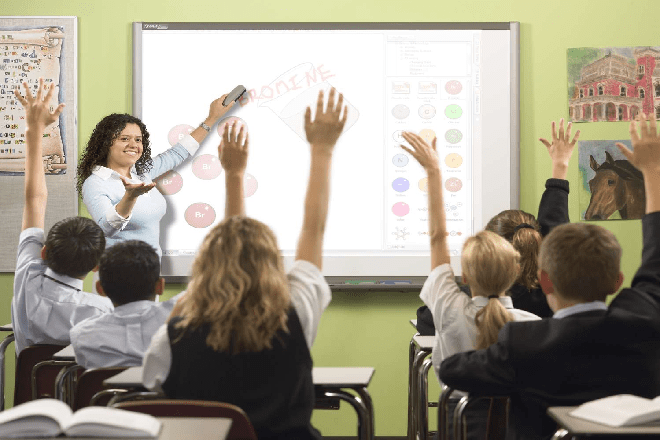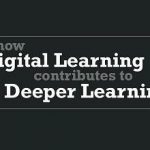This is a a guest post by Dr. Dheeraj Mehrotra
, Vice President (Academic Training/ School Audits) Next Education India Pvt Ltd.
Smart Board Based Learning : Replacing the BLACK Boards and Bored Lectures !
The 21st Century Education
talks are incomplete
if we do not refer to Smart Boards.
The interactive nature of the Smart Board provides many practical uses for the classroom. Using Smart Notebook software, teachers can record each step of a lesson activity for students to review at a later time.
The teacher if he needs respect must be of the opinion of Excellence. Education is the pathway to it. It is reflected by the involvement of the Quality Infrastructure at the learning arena which otherwise is not of any use.
The teachers, the knowledge facilitators need to harness the requirements to the best of their abilities and interest further. Hence, with no reason, the teachers need to have a balanced approach to policies and practices for children’s use of the Internet
. One must at the same time initiate conversations with teachers, administrators, and parents, rather than set and implement rules that may be perceived as too rigid. One must take note that all stakeholders have a chance to contribute to the decision-making process. There is no doubt in the fact that a computer and a great software can be fun and exciting learning tools, and can even provide practice of pre-academic and academic skills.
No wonder, we have e-classrooms now in many schools but does that solve the purpose? I doubt to my experience. It is the mindset of the teachers, the educators which needs to be functioned well for successful technology integration and education enhancement. The teacher ought to be a Trainer/Learner/All Rounder, with his/ her presence on the web mandatory. No longer having an email ID and an expertise of MS Office but more and more…viz….having a website, blog
, Wiki, and more, apart from being socially connected 24×7. Gone are the days of powerpoints. But at the same time it is indispensably true to keep in mind, however, that computer software cannot teach a child the concepts that he/she is not developmentally ready for. Computers should always be considered as a supplement to other, more concrete learning activities like completing puzzles, building with Lego and blocks, reading books, creating art projects and playing on the playground. It is universally true keeping the database analysis in view out of the day.
We believe that everyone should have access to technology. One way the software companies are helping to transform education for teachers and students through global partnerships. The teachers need to share a commitment to digital inclusion in education―inclusive classrooms, personalized learning
, and accessible technology. Various researchers and scholars have defined the need of Quality Education but no one has ever desired the need of “We” the teachers today to be interesting and “Informed” with the march of time or else we would be the only “Un-interested” thing (Identity) in the class, if we are not enriching and of any interest to the children to make them forget their Facebook Walls’ and the SMS which otherwise make their mind fertile of interest.
As a matter of fact, the mainstream computers and other technology used in classrooms
often include settings and features that enhance accessibility, yet many educators are not trained on accessibility, and do not know which features will help students with specific disabilities. Increasing awareness of available accessibility features and providing teacher training will help many students without requiring schools to acquire new technology.
As facilitators, we must be upto date in our pedagogical approaches. But most importantly, we must move towards autodidactism
, enabling the students to assume responsibility for their learning.
Teacher training and support is critical. Next Education
has paved the way for Indian Schools in a big way which includes ICT Hands on training for teachers and CCE implementation. For teachers to be able to help students personalize their PCs and adjust accessibility settings, teachers must first have the necessary knowledge, skills, and resources themselves. Also, accessibility is a complex subject that requires an understanding of how learning style differences and disabilities impact computer use. Teachers need to know who to contact within the school or local community for information about accessibility.
While research shows that combining ICT with innovative teaching practices strongly predicts students’ acquisition of 21st century skills, the challenge continues to be helping teachers develop the competencies needed to combine great learning activities with meaningful and relevant use of ICTs. There are many challenges to effective professional development of ICT integration:
- Many teachers are aware that they should integrate ICT into their teaching practices, but are uncertain as to what that actually means.
- The absence of a common internationally recognized standard in the area of ICT integration, as well as training based on those standards, prevents having a consistent method to assess teacher competency
- “One size fits all” training fails to address the needs of individuals. Teachers within one school will have very different needs. While some may have never used a computer, others will be using multiple devices and applications to achieve desired outcomes.
- Mandating training which is not relevant. Buy-in by the teacher, including the assessment and planning of their own development, decreases resistance to training and increases the likelihood that what is presented actually will result in a change in their teaching strategies.
- The ability to effectively scale largely face-to-face professional development to reach all teachers in a country is a daunting and expensive endeavor.
Cheers ! to our Educators today who are learning how to teach from the students today !! as far as the technology is concerned. What’s your say?


